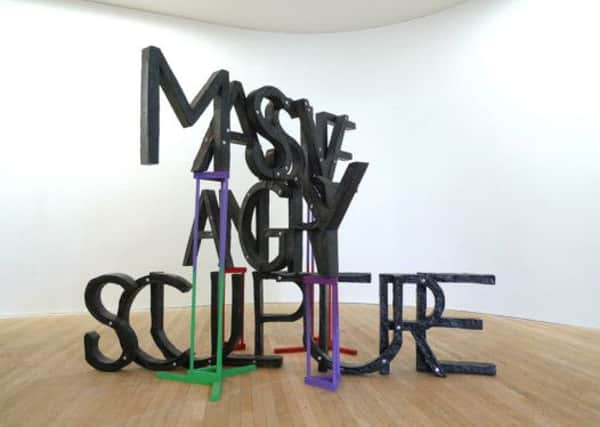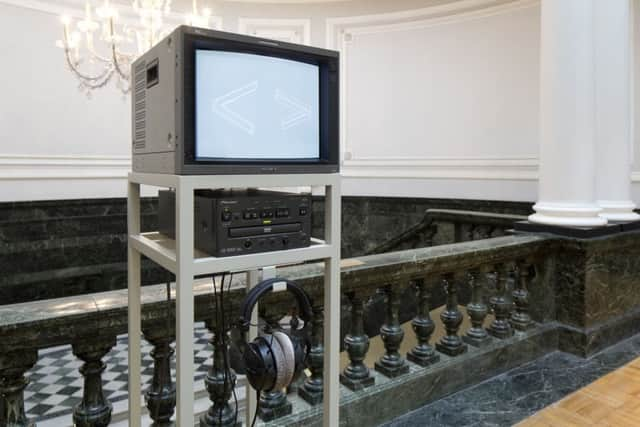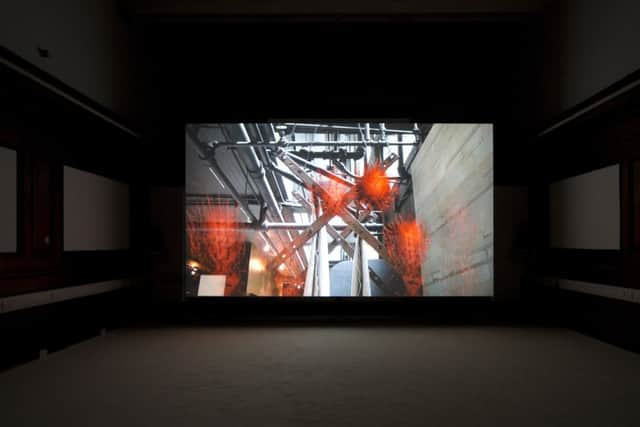Art review: Glasgow International


It’s getting late. I’m drinking gin and tonic, from that classy purveyor of wines and spirits known as Lidl, out of a plastic cup. I’m in a building I’ve never seen art in before, a dingy former café once filled with anxious folk about to appear at the adjacent Glasgow Sheriff Court. It’s dark outside and I’m alone in an upstairs room with a sculpture that is giving me the creeps. It consists of empty pistachio shells and dozens of dead wasps.
This is a small group show at 16 Nicholson Street, and part of the sixth Glasgow International, this year programmed under the curatorial vision of festival director Sarah McCrory. It’s the only visual art event I know that can take you from grand civic spaces like the Gallery of Modern Art and Kelvingrove Museum to the shop fronts and dead end streets, basement flats and underground car parks that are filled with the energy of the city’s thriving artist-led organisations.
Advertisement
Hide AdIn the space of a day I’ve had my fingernail decorated with an image of a lobster thanks to a beauty student from a local college who is working in an exhibition space-cum-artist nail bar using the designs of the artist Alistair Frost. I’ve missed a sold out performance, made it to a book launch. At a party at The Old Hairdressers someone insists on taking my photograph with an inflatable banana and blow up parrot.


At the Gallery of Modern Art I am suitably awed by Aleksandra Domanovic’s show. The ground floor gallery is hung floor to ceiling with successive giant images on suspended translucent sheets that emulate the acetates used in animation. Each has a science fiction theme: the plastic raincoat worn by the replicant Zhora in Bladerunner, for example, and the international space station from Gravity. Each of these films has strong, but at times ambiguous, female roles. Is there room for women in the fictional future? Printed on one of the giant banners is a historic rejection letter from the animation department at Disney. “Girls”, it patiently explains, “can’t be animation artists, but they will be employed for filling in.”
By the end of the day I’m beginning to feel like one of the old pieces of sculpture that have found themselves dragged out of storage for the exhibition at the Briggait entitled Reclaimed: the Second Life of Sculpture. I’m dusty and fractured while everyone else is shiny and sure of themselves. For this show you walk into the vast building that houses Wasps artists studios, and bump into a huge lump of bronze. It is The Spirit of Saint Kentigern, the sculpture by Neil Livingstone that once graced Buchanan Street. The central courtyard of the building holds 34 works of art dragged out of storage into the light of day, although many of them feel a little too new to be genuinely reclaimed. There’s a wonderful newness, though, to Michael Stumpf’s show at Glasgow School of Art where day-glo colours and bold shapes herald a supercharged reinvention of his subtle sculptural thinking to provide a true highlight of the festival.
At the Common Guild, the Mexican artist Gabriel Kuri’s austere exhibition reminds us that objects might have purpose as well as beauty. His floor sculptures look like the kind of minimalist sculpture you’d find in a museum but they are created from emergency foil blankets, stacks of matchboxes and pallets. A modular table with painted steel booths is a polling table, stuffed with neat piles of blankets and clothing. It makes you think of the election in Afghanistan. After the show the goods, including new sleeping bags, will be donated to charity.
A strange sub-theme of the shows put on across the city is ceramics. At Kendall Koppe’s gallery, exquisite bowls by the legendary 20th century potter Lucy Rie are installed on a curving plinth in the middle of the room. On the walls hang the homoerotic photographs of George Platt Lynes, an American photographer who died in 1955 and whose male nudes were unpublishable during his lifetime. Their theatrical beauty, lighting and staginess reflect his day job photographing ballet dancers. Upstairs Mary Mary is showing Jesse Wine’s ceramics set out in formal arrays, kitsch coil pots, sinister-looking platters and – best of all – great portrait heads with rusty glazes.


McCrory’s own programme feels energetic. At the McLellan Galleries, Charlotte Prodger’s video installations are set in an arresting context with a vast tarpaulin, of the kind that serves as the side of a lorry, bisecting the space. The power sockets embedded in the floor of the gallery are all exposed, circular discs of Perspex litter the floorboards. Downstairs the films of Jordan Wolfson range from the arch to the in your face. Even the toilet has been turned into a screening room.
Advertisement
Hide AdMcCrory’s programme at Tramway features the US artist Michael Smith, who has made a 30-year career out of his comedy eyebrows and his hapless character Mike’s attempts to live the American dream. You see him sneaking into other people’s prom photos, or in a lo-fi video work, being kidnapped by spooks whilst trying and failing to do the ironing.
I like the playful sensibility of McCrory’s festival: the unruliness embodied by Wolfson’s sinister film of a talking crow in the toilet. But there’s also a lack of balance, a lack of heft. The works at the centre feel a little too uniform in tone after a while. Somewhere amongst the noise there need to be moments of pause and thought and big festivals need considerable inter-generational dialogue.
Advertisement
Hide AdThis year that falls not to the Director’s Programme but to 42 Carlton Place, the small gallery run by painters Carol Rhodes and Merlin James. Their important show of the US painter Christina Ramberg (1946-1995) is a revelation for those of us who didn’t see her last significant British outing over 30 years ago. Ramberg’s paintings and drawings are perceptive riffs on the weirdness of femininity, the corsets and stays, elaborate hairstyles and odd costumes that designated femininity when she grew up. These days we often talk about how gender is constructed or performed, but Ramberg saw how it was literally constructed in line and shape, constraint and overemphasis.
Back at Tramway, Bedwyr Williams’s brilliant film Echt takes Ramberg’s ideas about shape and contour a step further. In a dystopian future a new feudal system has arisen where status and value are based on excessive consumption. Nightclub kings project their wealth and status by wearing too many baseball caps and shoelaces. Women wear cardigans so tightly packed they look like hunchbacks. Bouncers who once spent all their time pumping iron in gyms now indulge in elaborate facial exercises that make them grow odd lumps and bumps on their foreheads and chins. It is all projected from a bus that has been driven into the gallery, which has been set up as a forest clearing with trees and fences and fake mist. I find I am sitting, not on a seat, but on an old suitcase. Digital clocks flash on screen, cheap watches dazzle in the darkness. I’m finally adrift on art now… discombobulated.
• Glasgow International runs until 21 April. glasgowinternational.org